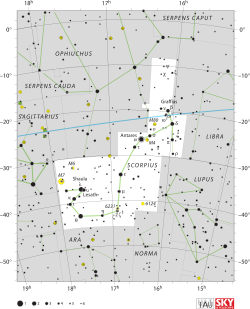1 Scorpii
| 1 Scorpii | |
 | |
| Observationsdata Epok: J2000.0 | |
|---|---|
| Stjärnbild | Skorpionen |
| Rektascension | 15t 50m 58,74452s[1] |
| Deklination | -25° 45′ 04,6649″[1] |
| Skenbar magnitud () | +4,63 (V)[2] |
| Stjärntyp | |
| Spektraltyp | B1.5 Vn[3] |
| B–V | -0,072 ± 0,003[2] |
| Astrometri | |
| Radialhastighet () | -3,0 ± 4,7[4] km/s |
| Egenrörelse (µ) | RA: -14,20[1] mas/år Dek.: -25,12[1] mas/år |
| Parallax () | 6,59 ± 0,27[1] |
| Avstånd | 490 ± 20 lå (152 ± 6 pc) |
| Absolut magnitud () | -1,27[2] |
| Detaljer | |
| Massa | 8,3 ± 0,2[5] M☉ |
| Radie | 3,7[6] R☉ |
| Luminositet | 3 890[6] L☉ |
| Temperatur | 24 000[6] K |
| Vinkelhastighet | 310 ± 0,5[7] km/s |
| Ålder | 10,3 ± 5,3[5] miljoner år |
| Andra beteckningar | |
| b Sco, 1 Sco, ALS 15017, CD-25 11131, CEL 4397, CPD-25 5667, GSC 06782-02148, HD 141637, HIC 77635, HIP 77635, HR 5885, IRAS 15479-2536, 2MASS J15505874-2545046, PPM 264768, SAO 183854, TD1 18601, TYC 6782-2148-1, uvby98 100141637, Gaia DR2 6236363539673265152 [8] | |
1 Scorpii, som är stjärnans Flamsteed-beteckning, är en ensam stjärna,[9] belägen i den mellersta delen av stjärnbilden Skorpionen och har även Bayer-beteckningen b Scorpii. Den har en skenbar magnitud av ca 4,63[2] och är svagt synlig för blotta ögat där ljusföroreningar ej förekommer. Baserat på parallaxmätning inom Hipparcosuppdraget på ca 6,6[1] mas, beräknas den befinna sig på ett avstånd på ca 490 ljusår (ca 152 parsek) från solen. Den rör sig närmare solen med en heliocentrisk radialhastighet på ca -3 km/s.[4] Stjärnan ingår med 89 procent sannolikhet i rörelsegruppen Scorpius OB2.[10][9]
Egenskaper
[redigera | redigera wikitext]1 Scorpii är en blå till vit stjärna i huvudserien av spektralklass B1.5 Vn,[3] där "n"-suffixet anger att den har "diffusa" absorptionslinjer i dess spektrum orsakade av snabb rotation. Den har en projicerad rotationshastighet på 310 km/s, vilket ger stjärnan en något tillplattad form med en ekvatorialradie som är 13 procent större än den polära radien.[7] Det finns vissa svaga bevis för att den är en Be-stjärna med en omgivande gasskiva som ses från sidan.[11] Den har en massa som är ca 8,3[5] solmassor, en radie, som är ca 3,7[6] solradier och utsänder från dess fotosfär ca 3 900[6] gånger mera energi än solen vid en effektiv temperatur av ca 24 000[6] K.
Referenser
[redigera | redigera wikitext]- Den här artikeln är helt eller delvis baserad på material från engelskspråkiga Wikipedia, 1 Scorpii, 30 april 2020.
Noter
[redigera | redigera wikitext]- ^ [a b c d e f] van Leeuwen, F. (2007), "Validation of the new Hipparcos reduction", Astronomy and Astrophysics, 474 (2): 653–664, arXiv:0708.1752, Bibcode:2007A&A...474..653V, doi:10.1051/0004-6361:20078357.
- ^ [a b c d] Anderson, E.; Francis, Ch. (2012), "XHIP: An extended hipparcos compilation", Astronomy Letters, 38 (5): 331, arXiv:1108.4971, Bibcode:2012AstL...38..331A, doi:10.1134/S1063773712050015.
- ^ [a b] Houk, Nancy; Smith-Moore, M. (1978), Michigan catalogue of two-dimensional spectral types for the HD stars, 4, Ann Arbor: Dept. of Astronomy, University of Michigan, Bibcode:1988mcts.book.....H.
- ^ [a b] de Bruijne, J. H. J.; Eilers, A.-C. (October 2012), "Radial velocities for the HIPPARCOS-Gaia Hundred-Thousand-Proper-Motion project", Astronomy & Astrophysics, 546: 14, arXiv:1208.3048, Bibcode:2012A&A...546A..61D, doi:10.1051/0004-6361/201219219, A61.
- ^ [a b c] Tetzlaff, N.; et al. (January 2011), "A catalogue of young runaway Hipparcos stars within 3 kpc from the Sun", Monthly Notices of the Royal Astronomical Society, 410 (1): 190–200, arXiv:1007.4883, Bibcode:2011MNRAS.410..190T, doi:10.1111/j.1365-2966.2010.17434.x.
- ^ [a b c d e f] Hernández, J. S.; et al. (2005), "Herbig Ae/Be Stars in nearby OB Associations", The Astronomical Journal, 129 (2): 856, arXiv:astro-ph/0410494, Bibcode:2005AJ....129..856H, doi:10.1086/426918.
- ^ [a b] Belle, G. T. (2012), "Interferometric observations of rapidly rotating stars", The Astronomy and Astrophysics Review, 20: 51, arXiv:1204.2572, Bibcode:2012A&ARv..20...51V, doi:10.1007/s00159-012-0051-2.
- ^ "b Sco". SIMBAD. Centre de données astronomiques de Strasbourg. Hämtad 2020-04-30.
- ^ [a b] Eggleton, P. P.; Tokovinin, A. A. (September 2008), "A catalogue of multiplicity among bright stellar systems", Monthly Notices of the Royal Astronomical Society, 389 (2): 869–879, arXiv:0806.2878, Bibcode:2008MNRAS.389..869E, doi:10.1111/j.1365-2966.2008.13596.x.
- ^ Rizzuto, Aaron; et al. (October 2011), "Multidimensional Bayesian membership analysis of the Sco OB2 moving group", Monthly Notices of the Royal Astronomical Society, 416 (4): 3108–3117, arXiv:1106.2857, Bibcode:2011MNRAS.416.3108R, doi:10.1111/j.1365-2966.2011.19256.x.
- ^ Rivinius, Th.; et al. (November 2006), "Bright Be-shell stars", Astronomy and Astrophysics, 459 (1): 137−145, Bibcode:2006A&A...459..137R, doi:10.1051/0004-6361:20053008.
Externa länkar
[redigera | redigera wikitext]Text is available under the CC BY-SA 4.0 license; additional terms may apply.
Images, videos and audio are available under their respective licenses.





